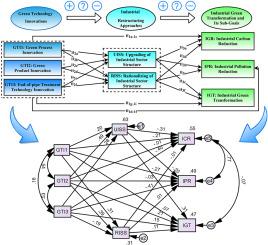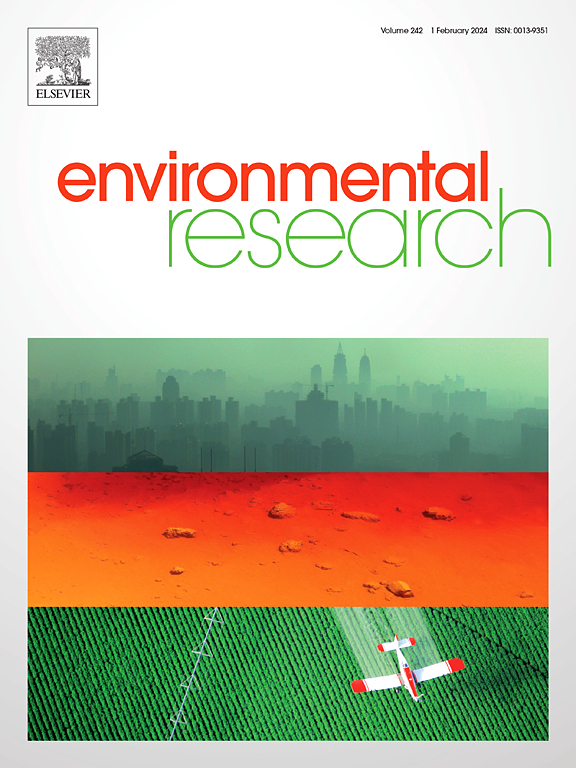Can green technology innovations achieve the collaborative management of pollution reduction and carbon emissions reduction? Evidence from the Chinese industrial sector
IF 7.7
2区 环境科学与生态学
Q1 ENVIRONMENTAL SCIENCES
引用次数: 0
Abstract
An appropriate green technology innovation and industrial structural adjustment can facilitate the transition to a greener industrial economy under the Sustainable Development Goals framework. The collaborative management of industrial pollution reduction (IPR) and industrial carbon dioxide emissions reduction (ICR) in the industrial green transformation (IGT) is increasingly drawing attention internationally. Using panel data from 2008 to 2021 for provincial industrial sectors in China, this study uses a structural equation model to empirically investigate how green technologies influence IGT and its sub-goals (including IPR and ICR) through industrial restructuring approaches. The results show that industrial green development have achieved significant results in the study period. Green technologies can achieve green development by inducing changes in industrial structure. As opposed to rationalizing industrial structure, the key to fostering sustainable industrial green transformation is to stimulate the upgrading of the industrial sector structure (UISS) through green technologies. After sorting out all the mediating mechanisms, green process (GTI1) or green product innovation (GTI2), by triggering UISS, is the key to achieving the collaborative management of IPR and ICR and can provide the impetus for the long-term intensification and greening of the industrial sector. In addition, the transmission paths of green technologies affecting IGT, IPR, and ICR are spatially heterogeneous. Our empirical findings can help local governments and policymakers in developing nations construct energy strategies and lessen regional variations in sustainable environmental development.

绿色技术创新能否实现污染减排与碳减排的协同管理?来自中国工业部门的证据。
在可持续发展目标框架下,适当的绿色技术创新和产业结构调整可促进向更绿色的工业经济转型。在工业绿色转型(IGT)中,工业污染减排(IPR)和工业二氧化碳减排(ICR)的协同管理日益受到国际关注。本研究利用 2008 年至 2021 年中国省级工业部门的面板数据,采用结构方程模型实证研究了绿色技术如何通过工业结构调整方法影响工业绿色转型及其子目标(包括知识产权和工业二氧化碳减排)。结果表明,在研究期间,工业绿色发展取得了显著成效。绿色技术可以通过引起产业结构的变化来实现绿色发展。相对于产业结构的合理化,促进可持续的工业绿色转型的关键在于通过绿色技术刺激工业部门结构的升级(UISS)。在梳理了所有中介机制之后,绿色工艺(GTI1)或绿色产品创新(GTI2)通过引发 UISS,是实现知识产权与 ICR 协同管理的关键,能够为工业部门的长期集约化和绿色化提供动力。此外,影响 IGT、IPR 和 ICR 的绿色技术的传播路径具有空间异质性。我们的实证研究结果可以帮助发展中国家的地方政府和政策制定者构建能源战略,减少可持续环境发展的地区差异。
本文章由计算机程序翻译,如有差异,请以英文原文为准。
求助全文
约1分钟内获得全文
求助全文
来源期刊

Environmental Research
环境科学-公共卫生、环境卫生与职业卫生
CiteScore
12.60
自引率
8.40%
发文量
2480
审稿时长
4.7 months
期刊介绍:
The Environmental Research journal presents a broad range of interdisciplinary research, focused on addressing worldwide environmental concerns and featuring innovative findings. Our publication strives to explore relevant anthropogenic issues across various environmental sectors, showcasing practical applications in real-life settings.
 求助内容:
求助内容: 应助结果提醒方式:
应助结果提醒方式:


